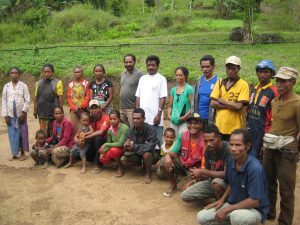It is a beautiful, but also difficult road leading up the mountain to the village Simhai. We pass lots of coffee trees which are growing here in the district of Ermera. The community lives up at the mountain and the road is not easy accessible. Community members use horses for their transport of food from the next village, but grow vegetables and fruits themselves. It is my first time to Simhai as my colleagues from Cruz Vermelha de Timor Leste (East Timor Red Cross) have just recently selected this new target village. There are 133 Households in Simhai, with approximately 200 people. In some houses there live two or three families, that’s why the numbers are different.
The community had expressed their interest for the project to Cruz Vermelha de Timor Leste as they would like to have latrines and a functioning water system. Currently they get their water from the river and a pipe they constructed from bamboo. There is only one existent latrine in Simhai and it isn’t used by many people as it also cannot be accessed easily.
 My first impression is that the people of Simhai care a lot for plants and flowers as they grow lots of them within the community. The houses are mostly far apart from each other and it might need a lot of walking to see more of the village. We arrive late and will continue the community dialogue with them tomorrow.
My first impression is that the people of Simhai care a lot for plants and flowers as they grow lots of them within the community. The houses are mostly far apart from each other and it might need a lot of walking to see more of the village. We arrive late and will continue the community dialogue with them tomorrow.
This is the second week Cruz Vermelha de Timor Leste (East Timor Red Cross) is working in Simhai. Firstly it is explained to the people of Simhai how the project is set up and what support will be given to them in terms of trainings, construction and technical know-how. Project activities, gender sensitivity as well as community resources are identified and discussed together. During the second part of the community process health volunteers and the members of the maintenance committee (GMF structure) will be identified and selected. Future community health volunteers will conduct house to house visits to inform/educate people about common health problems and show them practically how to improve their health. They will also check if latrines are used and maintained once they are constructed. Further, it will be their responsibility to check if the houses are clean and community members use their health knowledge. The members of the GMF group will be responsible to maintain the water system, check latrines, tanks and tap stands and will also be collecting some money/contribution from each community member to rehabilitate the water system (ongoing costs).
The community process is participatory and it is very important that the community itself selects their volunteers and agrees on the project rules and conditions. This ensures participation, motivation as well as sustainability for the project. The facilitators of Cruz Vermelha de Timor Leste have a lot of experience in mobilizing the community as they have received a special training. Everyone who is available joins us at the meeting and it’s nice to watch community members of all ages (children to elderly) gathering in the meeting hall. After we will finish the community process by the end of the week, the construction can start and the next task for the health team will be the community health volunteer training early next year. I think that the project had a good start in Simhai and look forward to the next couple of days.
